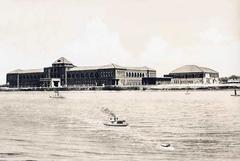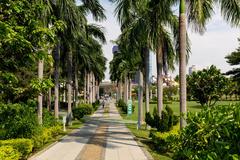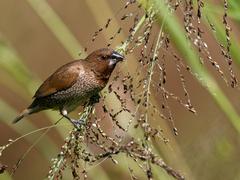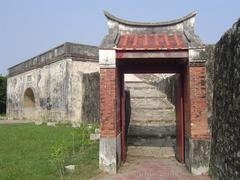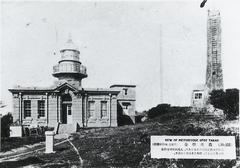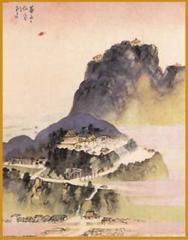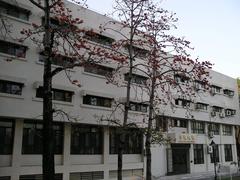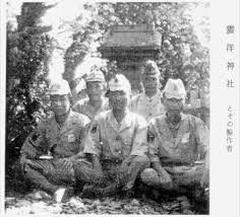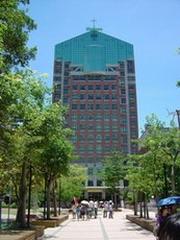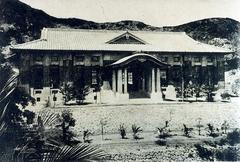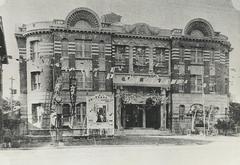Visiting Hours, Tickets, and Historical Significance of Kaohsiung Martyrs’ Shrine, Kaohsiung, Taiwan
Date: 16/08/2024
Introduction
Nestled on the scenic Shoushan mountainside in Kaohsiung City, Taiwan, the Kaohsiung Martyrs’ Shrine stands as a prominent historical and cultural landmark. Originally constructed in 1910 during the Japanese colonial period as a Shinto shrine, the site has undergone significant transformations that reflect Taiwan’s complex history. Following the end of World War II and Japan’s withdrawal from Taiwan, the shrine was repurposed to honor the martyrs of the National Revolutionary Army who fought during the Chinese Civil War (Traces of War). Today, the shrine serves as a place of remembrance, a tourist attraction, and an educational site, offering visitors a unique blend of Japanese and Chinese architectural styles along with stunning panoramic views of Kaohsiung City and its harbor (Travelling Welshman). This comprehensive guide aims to provide detailed information on the history, significance, and visitor experience of the Kaohsiung Martyrs’ Shrine, making it an essential read for anyone planning to visit this remarkable site.
Table of Contents
- History of Kaohsiung Martyrs’ Shrine
- Visitor Information
- Significance of Kaohsiung Martyrs’ Shrine
- Comprehensive Visitor Guide
History of Kaohsiung Martyrs’ Shrine
Origins as a Shinto Shrine
The Kaohsiung Martyrs’ Shrine, located on the scenic Shoushan mountainside in Kaohsiung City, Taiwan, has a rich and multifaceted history. Originally constructed in 1910 during the Japanese colonial period, the site was initially a Shinto shrine. This was a common practice by the Japanese colonial administration, which built Shinto shrines across Taiwan to promote Shintoism and Japanese culture among the local population. The shrine served as a place of worship and a symbol of Japanese authority and cultural influence in Taiwan (Traces of War).
Transformation Post-Japanese Era
Following Japan’s defeat in World War II and its subsequent withdrawal from Taiwan in 1945, the shrine underwent a significant transformation. Taiwan was returned to Chinese control, and the shrine was repurposed to honor the martyrs of the National Revolutionary Army who fought during the Chinese Civil War (1925-1947). This shift in purpose marked a significant change in the shrine’s role, from a symbol of Japanese colonial power to a memorial for Chinese soldiers who sacrificed their lives for the nation (Travels with Erica).
Architectural and Cultural Significance
The architectural design of the Kaohsiung Martyrs’ Shrine reflects its historical evolution. While the original Shinto elements have been largely replaced, the shrine retains a blend of Japanese and Chinese architectural styles. This unique combination makes it a fascinating site for those interested in the architectural and cultural history of Taiwan. The shrine’s location on Shoushan mountainside also offers a stunning panoramic view of Kaohsiung City and its harbor, adding to its allure as a tourist destination (Travelling Welshman).
Visitor Information
Visiting Hours
The Kaohsiung Martyrs’ Shrine is open daily from 8:00 AM to 5:00 PM. It is advisable to visit early in the morning or late in the afternoon to avoid crowds and enjoy the serene ambiance.
Tickets
Entry to the Kaohsiung Martyrs’ Shrine is free, making it an accessible and budget-friendly option for all visitors.
Special Events and Tours
The shrine occasionally hosts special ceremonies and events, especially during national holidays. Guided tours are available upon request and can provide deeper insights into the shrine’s history and significance.
Role in Modern Taiwan
Today, the Kaohsiung Martyrs’ Shrine serves multiple purposes. It is a place of remembrance for the fallen soldiers of the National Revolutionary Army, a tourist attraction, and a site for cultural and historical education. The shrine houses an archive with documents and objects related to its history, providing visitors with a deeper understanding of its significance. The site also features a ‘LOVE’ sign, a popular spot for photographs, especially among newly engaged couples (Travels with Erica).
Visitor Experience
Visitors to the Kaohsiung Martyrs’ Shrine can engage in various activities that enhance their understanding and appreciation of the site. The shrine itself is the main attraction, where visitors can wander around, take photographs, and absorb the historical ambiance. The view from the shrine is particularly breathtaking at sunrise and sunset, offering a picturesque backdrop for photography enthusiasts. Additionally, the shrine’s proximity to other attractions on Shoushan, such as the archaeological ruins and the Formosan Macaques, makes it a convenient stop for those exploring the area (Travelling Welshman).
Accessibility and Visitor Tips
Getting to the Kaohsiung Martyrs’ Shrine is relatively straightforward. From Formosa Boulevard Station, visitors can take the Orange metro line to Sizihwan Station (O1). From there, it is a short walk to the shrine, following a path that is not overly strenuous and accessible to most people without physical limitations. It is advisable to allot around 30 to 45 minutes to explore the shrine, depending on one’s interest in photography and historical details (Travels with Erica).
Nearby Attractions
The Kaohsiung Martyrs’ Shrine is part of a broader itinerary that includes several other notable attractions in Kaohsiung. Nearby, visitors can explore Cijin Island, accessible via a short ferry ride, where they can rent bikes and tour the island’s popular sites. Other attractions include the Takao Railway Museum, Pier-2 Art Centre, and various night markets, offering a comprehensive cultural experience of Kaohsiung (Travelling Welshman).
FAQs
Q: What are the Kaohsiung Martyrs’ Shrine visiting hours?
A: The shrine is open daily from 8:00 AM to 5:00 PM.
Q: Is there an entry fee for the Kaohsiung Martyrs’ Shrine?
A: No, entry to the shrine is free.
Q: Are guided tours available?
A: Yes, guided tours are available upon request.
Q: What is the best time to visit the shrine?
A: Early morning or late afternoon is the best time to visit to avoid crowds and enjoy the serene ambiance.
Significance of Kaohsiung Martyrs’ Shrine
A Symbol of Patriotism and Sacrifice
The Kaohsiung Martyrs’ Shrine stands as a poignant reminder of the sacrifices made by Taiwanese soldiers in defense of their homeland. This shrine is not merely a historical site but a living symbol of patriotism and courage. It honors those who lost their lives during significant conflicts such as the Chinese Civil War and World War II. The shrine’s role in fostering a sense of national pride and unity cannot be overstated. It serves as a place where the Taiwanese people can reflect on their history and the sacrifices that have shaped their nation.
Annual Commemorative Events
The shrine hosts a variety of commemorative events throughout the year, which are crucial in maintaining the collective memory of the fallen soldiers. One of the most significant events is the memorial service held on the anniversary of the end of World War II. This event draws large crowds, including government officials, military personnel, and civilians, all coming together to pay their respects. Another important event is the ceremony held on National Day, which honors the fallen soldiers and celebrates the nation’s resilience and independence. These events are not only acts of remembrance but also serve to educate younger generations about the importance of sacrifice and patriotism.
Architectural Significance
The architecture of the Kaohsiung Martyrs’ Shrine is imbued with symbolic meaning. The main hall, with its two-story structure and red-tiled roof, is a striking feature that immediately captures the attention of visitors. Inside, a large statue of a soldier holding a rifle stands as a powerful representation of the bravery and sacrifice of the soldiers. The memorial hall, adorned with a marble altar inscribed with the names of the fallen, serves as a solemn reminder of the lives lost in defense of Taiwan. The memorial tower, with its daily ringing bell, further emphasizes the ongoing remembrance of these sacrifices.
A Place of Solace and Reflection
For many, the Kaohsiung Martyrs’ Shrine is more than just a historical site; it is a place of solace and reflection. Families of the fallen soldiers often visit the shrine to mourn and remember their loved ones. The serene environment, coupled with the shrine’s solemn atmosphere, provides a space for quiet contemplation and emotional healing. The shrine’s role in offering solace to those who have lost loved ones in the line of duty is an essential aspect of its significance.
Educational Value
The shrine also serves an educational purpose. The exhibition hall within the shrine complex displays photographs and artifacts from the wars, providing visitors with a tangible connection to the past. This educational aspect is crucial in ensuring that the stories of the fallen soldiers are not forgotten. Schools and educational institutions often organize trips to the shrine, allowing students to learn about their nation’s history in a meaningful and impactful way.
Cultural and Historical Context
The Kaohsiung Martyrs’ Shrine is situated on the mountainside of Shoushan, a location that offers breathtaking views of Kaohsiung Harbor, Gushan, Cijin, and downtown Kaohsiung. This strategic location adds to the shrine’s significance, as it provides a panoramic view of the city that the soldiers fought to protect. The shrine’s history is also deeply intertwined with Taiwan’s colonial past. Originally established as Takao Kotohira Shrine during Japanese rule in 1910, it was later converted into a Chinese palatial architecture after the war. This transformation reflects Taiwan’s complex history and the various cultural influences that have shaped the nation.
A Popular Tourist Attraction
In recent years, the Kaohsiung Martyrs’ Shrine has become a popular tourist attraction. Visitors are drawn not only by the shrine’s historical and cultural significance but also by the stunning views it offers. The viewing platform, with its iconic LOVE sign, has become a favorite backdrop for pre-wedding photoshoots and social media posts. The shrine’s popularity among tourists helps to ensure that the stories of the fallen soldiers continue to be shared and remembered by a wider audience.
Integration with Nature
The shrine’s location on Shoushan, also known as Monkey Mountain, integrates it seamlessly with the natural environment. The area is home to numerous species of plants and Formosan Macaques, adding to the shrine’s allure. Visitors can enjoy a hike on the mountain trails, which offer additional opportunities for reflection and connection with nature. The integration of the shrine with its natural surroundings enhances its role as a place of solace and contemplation.
Comprehensive Visitor Guide
Best Time to Visit
The optimal time to visit is between November and April, when the weather is more temperate. December is particularly favorable for budget travelers due to lower hotel prices (Where and When).
Getting There
Conveniently located on Shoushan, the shrine is accessible via MRT to Yanchengpu Station, followed by a short walk or taxi ride. Buses and taxis are also readily available. For a more active approach, rent a bicycle using the EasyCard system (A Free Soul Abroad).
Entrance and Fees
The shrine is open to the public and free of charge, making it an excellent option for budget-conscious travelers.
What to Wear
Wear comfortable walking shoes and lightweight, breathable clothing. Modest attire is encouraged out of respect for the site’s cultural significance.
Photography
Photography is allowed, but be respectful of your surroundings and other visitors. The panoramic views of Kaohsiung from the shrine are particularly photogenic.
Facilities
Restrooms are available, but it’s advisable to bring water and snacks. There are convenience stores and eateries nearby.
Cultural Etiquette
Maintain a respectful demeanor. Refrain from loud conversations and disruptive behavior. Bow slightly when entering the shrine as a sign of respect.
Accessibility
The shrine is partially accessible to visitors with mobility issues. Check in advance for specific accessibility needs.
Safety Tips
Keep personal belongings secure and be aware of your surroundings. The hike to the shrine can be steep, so watch your step and stay hydrated.
Language
While many signs are in both Mandarin and English, a translation app or basic understanding of Mandarin can enhance your visit.
Local Customs
Respect local customs by not littering and following posted guidelines. Removing shoes is customary in certain areas, though not typically required at the shrine.
Souvenirs and Shopping
While the shrine does not have a dedicated gift shop, nearby vendors offer traditional Taiwanese crafts, local snacks, and trinkets.
Environmental Considerations
Carry reusable water bottles and avoid single-use plastics. Preserving the natural beauty of the area is a shared responsibility.
FAQ
Q: What are the visiting hours for Kaohsiung Martyrs’ Shrine?
A: The Kaohsiung Martyrs’ Shrine is open 24 hours a day.
Q: Is there an admission fee to visit the Kaohsiung Martyrs’ Shrine?
A: No, there is no admission fee to visit the shrine.
Q: How can I get to the Kaohsiung Martyrs’ Shrine?
A: The shrine is easily accessible by public transportation, including buses and taxis. It is also a short drive from downtown Kaohsiung.
Q: Are there any guided tours available?
A: Yes, guided tours are available and can provide more in-depth information about the shrine’s history and significance.
Q: What other attractions are nearby?
A: Nearby attractions include the Shoushan Zoo, the British Consulate at Takow, and Cijin Island.
Conclusion
The Kaohsiung Martyrs’ Shrine is a site of immense significance, serving as a symbol of patriotism, a place of solace, and an educational resource. Its architectural features, annual commemorative events, and integration with nature all contribute to its importance. As a popular tourist attraction, the shrine ensures that the sacrifices of Taiwan’s fallen soldiers are remembered and honored by both locals and visitors from around the world. To stay updated on events and information, consider following related social media channels or downloading visitor apps for the latest updates.
References
- Traces of War, 2022, unknown source url
- Travels with Erica, 2022, Erica source url
- Travelling Welshman, 2022, unknown source url
- Awe-Inspiring Places, 2022, unknown source url
- Where and When, 2022, unknown source url
- A Free Soul Abroad, 2022, unknown source url
- Wikipedia, 2022, unknown source url
- RTaiwanR, 2022, unknown source url
